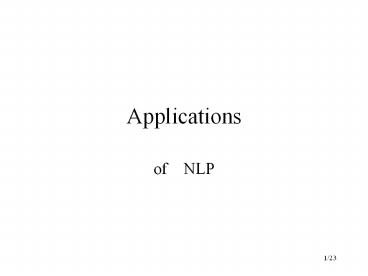Applications - PowerPoint PPT Presentation
Title:
Applications
Description:
Handling of anaphora. e.g. When is the next flight to Sydney? ... Also involves recognizing synonyms, and processing anaphora. 13 /23. Automatic summarization ... – PowerPoint PPT presentation
Number of Views:39
Avg rating:3.0/5.0
Title: Applications
1
Applications
- of NLP
2
Applications
- Text-to-speech, speech-to-text
- Dialogues sytems / conversation machines
- NL interfaces to
- QA systems
- IR systems
- Text summarization and text mining
- Story understanding inference, paraphrase
- Machine Translation
- Better word processing
- Language teaching
- Assistive computing
3
Speech applications
- (apart form the speech processing aspects)
- Text-to-speech
- Homograph disambiguation
- Prosody determination
- Speech-to-text
- To support phoneme recognition
- Homophone disambiguation
- Filtering of performance errors
4
Dialogue systems
- Usually speech-driven, but text also appropriate
- Modern application is automatic transaction
processing - Limited domain may simplify language aspect
- Domain model will play a big part
5
Dialogue systems
- Apart from speech issues, NL components include
- Topic tracking
- Anaphora resolution
- Reply generation
6
(also know as)Conversation machines
- Another old AI goal (cf. Turing test)
- Also (amazingly) for amusement
- Mainly speech, but also text based
- Early famous approaches include ELIZA, which
showed what you could do by cheating - Modern versions have a lot of NLP, especially
discourse modelling, and focus on the language
generation component
7
QA systems
- NL interface to knowledge database
- Handling queries in a natural way
- Must understand the domain
- Even if typed, dialogue must be natural
- Handling of anaphora
- e.g. When is the next flight to Sydney?
- And the one after?
- What about Melbourne then?
6.50 7.50 7.20
OK Ill take the last one.
8
IR systems
- Like QA systems, but the aim is to retrieve
information from textual sources that contain the
info, rather than from a structured data base - Two aspects
- Understanding the query (cf Google, Ask Jeeves)
- Processing text to find the answer
- Named Entity Recognition
9
(No Transcript)
10
(No Transcript)
11
(No Transcript)
12
Named entity recognition
- Typical textual sources involve names (people,
places, corporations), dates, amounts, etc. - NER seeks to identify these strings and label
them - Clues are often linguistic
- Also involves recognizing synonyms, and
processing anaphora
13
Automatic summarization
- Renewed interest since mid 1990s, probably due to
growth of WWW - Different types of summary
- indicative vs. informative
- abstract vs. extract
- generic vs. query-oriented
- background vs. just-the-news
- single-document vs. multi-document
14
Automatic summarization
- topic identification
- stereotypical text structure
- cue words
- high-frequency indicator phrases
- intratext connectivity
- discourse structure centrality
- topic fusion
- concept generalization
- semantic association
- summary generation
- sentence planning to achieve information
compaction
15
Text mining
- Discovery by computer of new, previously unknown
information, by automatically extracting
information from different written resources
(typically Internet) - Cf data mining (e.g. using consumer purchasing
patterns to predict which products to place close
together on shelves), but based on textual
information - Big application area is biosciences
16
Text mining
- preprocessing of document collections (text
categorization, term extraction) - storage of the intermediate representations
- techniques to analyze these intermediate
representations (distribution analysis,
clustering, trend analysis, association rules,
etc.) - visualization of the results.
17
Story understanding
- An old AI application
- Involves
- Inference
- Ability to paraphrase (to demonstrate
understanding) - Requires access to real-world knowledge
- Often coded in scripts and frames
18
Machine Translation
- Oldest non-numerical application of computers
- Involves processing of source-language as in
other applications, plus - Choice of target-language words and structures
- Generation of appropriate target-language strings
- Main difficulty is source-language analysis
and/or cross-lingual transfer implies varying
levels of understanding, depending on
similarities between the two languages
19
Machine Translation
- First approaches perhaps most intuitive look up
words and then do local rearrangement - Second generation took linguistic approach
grammars, rule systems, elements of AI - Recent (since 1990) trend to use empirical
(statistical) approach based on large corpora of
parallel text - Use existing translations to learn translation
models, either a priori (Statistical MT machine
learning) or on the fly (Example-based MT
case-based reasoning) - Convergence of empirical and rationalist
(rule-based) approaches learn models based on
treebanks or similar.
20
Better word processing
- Spell checking for homonyms
- Grammar checking
- Especially for non-native users
- Interference checking
- Intelligent word processing
- Find/replace that knows about morphology, syntax
21
Language teaching
- CALL
- As in previous slide (grammar checking) but
linked to models of - The topic
- The learner
- The teaching strategy
- Grammars (etc) can be used to create
language-learning exercises and drills
22
Assistive computing
- Interfaces for disabled
- Many devices involve language issues, e.g.
- Text simplification or summarization for users
with low literacy (partially sighted, dyslexic,
non-native speaker, illiterate, etc.) - Text completion (predictive or retrospective)
- Works on basis of probabilities or previous
examples
23
Conclusion
- Many different applications
- But also many common elements
- Basic tools (lexicons, grammars)
- Ambiguity resolution
- Need (but impossibility of having) for real-world
knowledge - Humans are really very good at language
- Can understand noisy or incomplete messages
- Good at guessing and inferring

